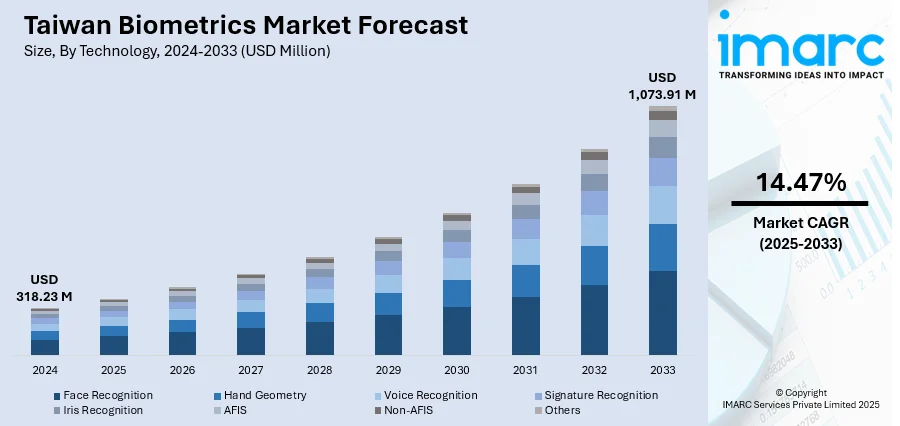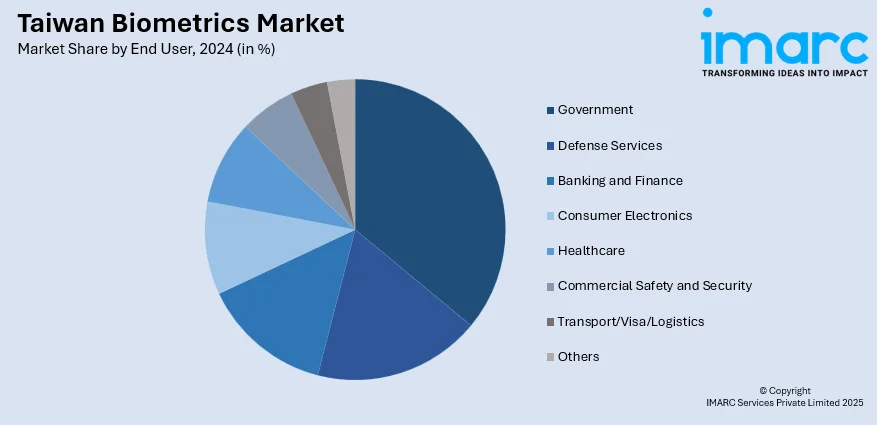
Taiwan Biometrics Market Size, Share, Trends and Forecast by Technology, Functionality, Component, Authentication, End User and Region, 2025-2033
Taiwan Biometrics Market Overview:
The Taiwan biometrics market size reached USD 318.23 Million in 2024. Looking forward, the market is expected to reach USD 1,073.91 Million by 2033, exhibiting a growth rate (CAGR) of 14.47% during 2025-2033. The market is fueled by robust government backing for digital identity initiatives, advancements in AI and semiconductor technology, and pervasive adoption of smart city infrastructure. Rising demand for secure contactless authentication across banking, healthcare, and public services, coupled with high rates of internet penetration and a technology-aware population, are also driving adoption. Companies adopting biometric solutions to improve cybersecurity and simplify identity management are further increasing Taiwan biometrics market share.
|
Report Attribute
|
Key Statistics
|
|---|---|
|
Base Year
|
2024
|
|
Forecast Years
|
2025-2033
|
|
Historical Years
|
2019-2024
|
| Market Size in 2024 | USD 318.23 Million |
| Market Forecast in 2033 | USD 1,073.91 Million |
| Market Growth Rate 2025-2033 | 14.47% |
Taiwan Biometrics Market Trends:
Digital Identity & Regulatory Innovation
Taiwan's biometrics market is shaped considerably by its forward-thinking strategy for digital identity. Initiatives have been promoted by the government to implement biometric authentication into national digital identification systems, allowing safe and efficient engagement in sectors like banking, health, and public services. Public involvement has been an integral part of these initiatives, with public workshops organized to discuss issues related to data protection and consent. Consequently, biometric technologies within Taiwan are being crafted with user control and transparency at their center. The regulatory environment has also changed in lockstep with this digital transformation by revising regulations to permit greater use of biometric authentication across financial services. This has allowed banks and fintech companies to implement facial recognition, fingerprint scanning, and behavioral biometrics more easily. As regulatory innovation is progressing together with technological progress, Taiwan is emerging as a regional powerhouse of secure, citizen-focused digital identities based on biometric authentication.

To get more information on this market, Request Sample
Smart Infrastructure and Local Innovation Ecosystem
Taiwan's intensive development of smart cities is pushing the deployment of biometric technologies for an extensive array of public and private uses. Government-initiated projects in urban centers such as Taipei, Taichung, and Kaohsiung are promoting facial recognition and AI-based surveillance to increase public safety, transportation, and infrastructure efficiency. These technologies are being introduced into traffic command centers, subway stations, and smart light grids, supporting real-time management of cities. Taiwan's highly concentrated industrial and tech areas, especially in Hsinchu, have also emerged as bases for the creation of sophisticated biometric sensors and software. Local players are investing in edge computing, IoT, and machine learning to power more responsive and privacy-sensitive biometric applications. The partnership among government institutions, academia, and private technology companies provides an innovation ecosystem that enables ongoing improvement. This localized innovation, combined with a willingness to accommodate international collaboration, is building a dynamic space where biometrics are at the forefront of the nation's digital transformation, which further contributes to the Taiwan biometrics market growth as well.
Technological Innovations & Wider Market Integration
Taiwan's prowess in semiconductor production and AI innovation is propelling emerging biometrics technologies. The industry is transcending basic fingerprint and facial recognition to adopt multi-modal systems blending voice, iris, and behavioral biometrics to achieve greater precision and security. These technologies are being embedded across sectors like retail and e-commerce, where they offer personalized customer experience, to healthcare, where biometric ID provides secure access to patient information. The banking sector is embracing biometric authentication for mobile banking and digital payments security, while business enterprises use it to enable zero-trust security frameworks. Meanwhile, smart home devices and wearable technology are incorporating biometrics to provide easy access control. As cyber-attacks are on the rise, biometric authentication is being recognized as a critical layer in identity and access management solutions. With steady investment in R&D and robust tech infrastructure, Taiwan's biometric market continues to grow while also becoming a standard-bearer of security, convenience, and innovation for Asia.
Taiwan Biometrics Market Segmentation:
IMARC Group provides an analysis of the key trends in each segment of the market, along with forecasts at the country and regional levels for 2025-2033. Our report has categorized the market based on technology, functionality, component, authentication, and end user.
Technology Insights:
- Face Recognition
- Hand Geometry
- Voice Recognition
- Signature Recognition
- Iris Recognition
- AFIS
- Non-AFIS
- Others
The report has provided a detailed breakup and analysis of the market based on technology. This includes face recognition, hand geometry, voice recognition, signature recognition, iris recognition, AFIS, non-AFIS, and others.
Functionality Insights:
- Contact
- Non-contact
- Combined
The report has provided a detailed breakup and analysis of the market based on the functionality. This includes contact, non-contact, and combined.
Component Insights:
- Hardware
- Software
A detailed breakup and analysis of the market based on the component have also been provided in the report. This includes hardware and software.
Authentication Insights:
- Single-Factor Authentication
- Multifactor Authentication
The report has provided a detailed breakup and analysis of the market based on the authentication. This includes single-factor authentication and multifactor authentication.
End User Insights:

- Government
- Defense Services
- Banking and Finance
- Consumer Electronics
- Healthcare
- Commercial Safety and Security
- Transport/Visa/Logistics
- Others
A detailed breakup and analysis of the market based on the end user have also been provided in the report. This includes government, defense services, banking and finance, consumer electronics, healthcare, commercial safety and security, transport/visa/logistics, and others.
Regional Insights:
- Northern Taiwan
- Central Taiwan
- Southern Taiwan
- Eastern Taiwan
The report has also provided a comprehensive analysis of all the major regional markets, which includes Northern Taiwan, Central Taiwan, Southern Taiwan, and Eastern Taiwan.
Competitive Landscape:
The market research report has also provided a comprehensive analysis of the competitive landscape. Competitive analysis such as market structure, key player positioning, top winning strategies, competitive dashboard, and company evaluation quadrant has been covered in the report. Also, detailed profiles of all major companies have been provided.
Taiwan Biometrics Market News:
- In April 2025, Tainan, the sixth-largest city in Taiwan, announced a pilot program to use AI-based facial recognition at ATMs to combat fraud. The system will prompt users to remove face coverings and will trigger an alarm for bank staff if a face isn't recognized, acting as a deterrent rather than blocking transactions. This differs from previous systems in Taiwan that focused on customer authentication.
Taiwan Biometrics Market Report Coverage:
| Report Features | Details |
|---|---|
| Base Year of the Analysis | 2024 |
| Historical Period | 2019-2024 |
| Forecast Period | 2025-2033 |
| Units | Million USD |
| Scope of the Report |
Exploration of Historical Trends and Market Outlook, Industry Catalysts and Challenges, Segment-Wise Historical and Future Market Assessment:
|
| Technologies Covered | Face Recognition, Hand Geometry, Voice Recognition, Signature Recognition, Iris Recognition, AFIS, Non-AFIS, Others |
| Functionalities Covered | Contact, Non-contact, Combined |
| Components Covered | Hardware, Software |
| Authentications Covered | Single-Factor Authentication, Multifactor Authentication |
| End Users Covered | Government, Defense Services, Banking and Finance, Consumer Electronics, Healthcare, Commercial Safety and Security, Transport/Visa/Logistics, Others |
| Regions Covered | Northern Taiwan, Central Taiwan, Southern Taiwan, Eastern Taiwan |
| Customization Scope | 10% Free Customization |
| Post-Sale Analyst Support | 10-12 Weeks |
| Delivery Format | PDF and Excel through Email (We can also provide the editable version of the report in PPT/Word format on special request) |
Key Questions Answered in This Report:
- How has the Taiwan biometrics market performed so far and how will it perform in the coming years?
- What is the breakup of the Taiwan biometrics market on the basis of technology?
- What is the breakup of the Taiwan biometrics market on the basis of functionality?
- What is the breakup of the Taiwan biometrics market on the basis of component?
- What is the breakup of the Taiwan biometrics market on the basis of authentication?
- What is the breakup of the Taiwan biometrics market on the basis of end user?
- What is the breakup of the Taiwan biometrics market on the basis of region?
- What are the various stages in the value chain of the Taiwan biometrics market?
- What are the key driving factors and challenges in the Taiwan biometrics market?
- What is the structure of the Taiwan biometrics market and who are the key players?
- What is the degree of competition in the Taiwan biometrics market?
Key Benefits for Stakeholders:
- IMARC’s industry report offers a comprehensive quantitative analysis of various market segments, historical and current market trends, market forecasts, and dynamics of the Taiwan biometrics market from 2019-2033.
- The research report provides the latest information on the market drivers, challenges, and opportunities in the Taiwan biometrics market.
- Porter's five forces analysis assist stakeholders in assessing the impact of new entrants, competitive rivalry, supplier power, buyer power, and the threat of substitution. It helps stakeholders to analyze the level of competition within the Taiwan biometrics industry and its attractiveness.
- Competitive landscape allows stakeholders to understand their competitive environment and provides an insight into the current positions of key players in the market.
Need more help?
- Speak to our experienced analysts for insights on the current market scenarios.
- Include additional segments and countries to customize the report as per your requirement.
- Gain an unparalleled competitive advantage in your domain by understanding how to utilize the report and positively impacting your operations and revenue.
- For further assistance, please connect with our analysts.
 Request Customization
Request Customization
 Speak to an Analyst
Speak to an Analyst
 Request Brochure
Request Brochure
 Inquire Before Buying
Inquire Before Buying




.webp)




.webp)












